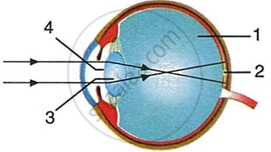Advertisements
Advertisements
प्रश्न
Given alongside is a diagram depicting a defect of the human eye. Study the same and answer the questions that follow:
 |
- Name the defect shown in the diagram.
- Give two possible reasons for this defect.
- Name the parts labelled 1 to 4.
- Name the type of lens used to correct this eye defect.
- Draw a labelled diagram to show how the above mentioned defect is rectified using the lens named above.
उत्तर
- Shortsighted, or myopia.
- The eyeball becomes long from front to back. The lens becomes too curved/convex.
-
- Vitreous humour
- Blind spot
- Lens
- Pupil
- Concave lens

संबंधित प्रश्न
A student suffering from myopia is not able to see distinctly the objects placed beyond 5 m. List two possible reasons due to which this defect of vision may have arisen. With the help of ray diagrams, explain
(i) why the student is unable to see distinctly the objects placed beyond 5 m from his eyes.
(ii) the type of the corrective lens used to restore proper vision and how this defect is corrected by the use of this lens.
(b) If, in this case, the numerical value of the focal length of the corrective lens is 5 m, find the power of the lens as per the new Cartesian sign convention
Explain two possible reasons of myopia. How can it be corrected? Explain with a suitable diagram.
A student is unable to see clearly the words written on the black board placed at a distance of approximately 3 m from him. Name the defect of vision the boy is suffering from. State the possible causes of this defect and explain the method of correcting it.
Which defect of vision can be rectified:
by using a convex lens?
What is the scientific name of
long-sightedness?
Name the defect of vision which makes the eye-lens cloudy resulting in blurred vision.
Name any two defects of vision which can be corrected by using spectacles.
Name one defect of vision (or eye) which cannot be corrected by any type of spectacle lenses.
What are the two most common defects of vision (or defects of eye)? How are they corrected?
A person can read a book clearly only if he holds it at an arm's length from him. Name the defect of vision:
if the person is a young man
Name the following:
The photosensitive pigment present in the rods of the retina.
Differentiate between members of the following pair with reference to what is asked in the bracket.
Rods and cones (sensitivity).
Have a look at the posture of this girl who is reading a book and answer the questions which follow:

Name the problem she is facing.
Select the odd one in the following series:
Endolymph, Tympanic membrane, Semi-circular canal, Blind spot.
Rewrite the following table so as to match second and third column with first column.
|
Column I
|
Column II
|
Column III
|
|
(i) Myopia
|
Old age problem
|
Bifocal lens
|
|
(ii) Presbyopia
|
Nearsightedness
|
Concave lens.
|
What type of lens is used to correct Hypermetropia?
Given below is a diagrammatic representation of a defect of the human eye:

(i) Identify the defect.
(ii) Mention two reasons for the above defect.
(iii) State how the defect can be rectified.
(iv) Name the part of the eye responsible for maintaining the shape of the eyeball.
Choose the Odd One Out:
Nearsightedness : concave lens : : farsightedness : _______
Assertion: Myopia is the defect of vision in which a person cannot see distant objects clearly.
Reason: This due to eye-ball being too short.
